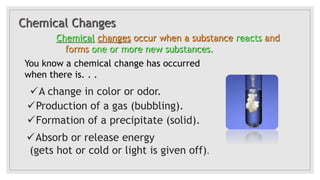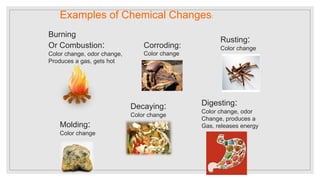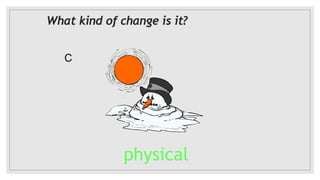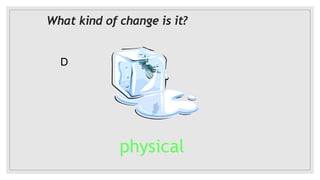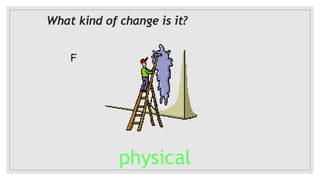matter.pptx
- 4. Objectives: 1. Differentiate the states of matter 2. Identify the physical and chemical properties of matter 3. Differentiate physical from chemical change
- 6. Identify if the word is a matter or not 1. Chair 2. Love 3. Book 4. Ice 5. Coffee 6. Kind 7. Laptop 8. Cellphone 9. Air 10.Helium
- 7. STATES OF MATTER FERMIONIC CONDENSATES
- 8. How can you distinguish the different states of matter? MACROSCOPIC MICROSCOPIC
- 9. MACROSCOPIC MICROSCOPIC • sense of sight • sense of touch • sense of hearing • sense of taste • sense of smell • Atoms (Shape and Volume) • Motion of particles(freely/not) • Energy when heated • Compressible • Forces of attraction
- 11. Other states of matter Plasma Bose- Einstein Condensate Fermionic Condensate
- 14. Other states of matter Bose- Einstein Condensate Fermionic Condensate
- 17. How can you distinguish the two houses?
- 18. Physical and Chemical Properties of Matter
- 19. Properties ◦use to identify different samples of matter. ◦Physical ◦Chemical
- 20. Physical Properties ◦ Can be observed without changing the composition of a matter EXAMPLES Melting point, boiling point, odor, color, taste, solubility, density, hardness, softness, ductility, malleability, viscosity, heat and electrical conductivity.
- 21. ◦Ductile-- ability to hammered ◦Malleability - Ability to deform and change the shape ◦Viscosity - Ability of to flow
- 22. Physical change ◦Process that occurs when composition of a matter is not altered ◦Change in matter is bought about by absorbing or releasing an amount of energy or heat
- 23. ENDOTHERMI C -absorbs heat or energy EXOTHERMIC -Releases heat or energy
- 24. Endothermic ◦Melting- solid to liquid ◦Evaporation- liquid to gas ◦Sublimation- solid to gas
- 25. Exothermic Freezing- liquid to solid Condensation- gas to liquid Deposition- gas to solid
- 26. Examples of physical change ◦Cutting of nails ◦Freezing of Ice ◦Melting of ice cream ◦Drying of clothes ◦Chopping of wood
- 27. Chemical Properties ◦When the substance undergoes a change in its composition EXAMPLE Combustion, flammability, electrolysis, and reactivity.
- 28. ◦Combustion complete burning with oxygen. ◦Flammability is the ability of matter to burn. Wood is flammable; iron is not. ◦Electrolysis is an electrochemical process in which electricity is used to split ◦water into two gases, hydrogen and oxygen.
- 29. ◦Reactivity is the ability of matter to combine chemically with other substances. ◦For example, iron is highly reactive with oxygen.
- 30. Chemical change ◦Process that occurs when composition of a matter is altered or changed
- 31. Chemical Changes Chemical changes occur when a substance reacts and forms one or more new substances. Formation of a precipitate (solid). A change in color or odor. Production of a gas (bubbling). You know a chemical change has occurred when there is. . . Absorb or release energy (gets hot or cold or light is given off).
- 32. Examples of Chemical Changes: Burning Or Combustion: Color change, odor change, Produces a gas, gets hot Corroding: Color change Rusting: Color change Molding: Color change Decaying: Color change Digesting: Color change, odor Change, produces a Gas, releases energy
- 33. Examples of chemical change ◦Baking ◦Burning ◦Fireworks ◦Rusting of metal ◦Cooking an egg
- 34. physical What kind of change is it? A
- 35. chemical What kind of change is it? B
- 36. physical What kind of change is it? C
- 37. physical What kind of change is it? D
- 38. chemical What kind of change is it? E
- 39. physical What kind of change is it? F
Editor's Notes
- your senses – sight, hearing, taste, touch and smell. matter made of atoms particles always in motion has energy, transferred when hitTED
- your senses – sight, hearing, taste, touch and smell. matter made of atoms particles always in motion has energy, transferred when hitTED Firces of attraction Attractive forces exist within and between particles. 2 types Intramolecular = within molecules Intermolecular = between molecules
- plasmas are made up of atoms in which some or all of the electrons have been stripped away and positively charged nuclei, called ions, roam freely. Plasma is superheated matter – so hot that the electrons are ripped away from the atoms forming an ionized gas. It comprises over 99% of the visible universe. In the night sky, plasma glows in the form of stars, nebulas, and even the auroras that sometimes ripple above the north and south poles. That branch of lightning that cracks the sky is plasma, so are the neon signs along our city streets. And so is our sun, the star that makes life on earth possible. Because so much of the universe is made of plasma, its behavior and properties are of intense interest to scientists in many disciplines. Importantly, at the temperatures required for the goal of practical fusion energy, all matter is in the form of plasma. Researchers have used the properties of plasma as a charged gas to confine it with magnetic fields and to heat it to temperatures hotter than the core of the sun. Other researchers pursue plasmas for making computer chips, rocket propulsion, cleaning the environment, destroying biological hazards, healing wounds and other exciting applications.
- plasmas are made up of atoms in which some or all of the electrons have been stripped away and positively charged nuclei, called ions, roam freely. Plasma is superheated matter – so hot that the electrons are ripped away from the atoms forming an ionized gas. It comprises over 99% of the visible universe. In the night sky, plasma glows in the form of stars, nebulas, and even the auroras that sometimes ripple above the north and south poles. That branch of lightning that cracks the sky is plasma, so are the neon signs along our city streets. And so is our sun, the star that makes life on earth possible. Because so much of the universe is made of plasma, its behavior and properties are of intense interest to scientists in many disciplines. Importantly, at the temperatures required for the goal of practical fusion energy, all matter is in the form of plasma. Researchers have used the properties of plasma as a charged gas to confine it with magnetic fields and to heat it to temperatures hotter than the core of the sun. Other researchers pursue plasmas for making computer chips, rocket propulsion, cleaning the environment, destroying biological hazards, healing wounds and other exciting applications.
- In condensed matter physics, a Bose–Einstein condensate (BEC) is a state of matter that is typically formed when a gas of bosons at low densities is cooled to temperatures very close to absolute zero (−273.15 °C or −459.67 °F). Under such conditions, a large fraction of bosons occupy the lowest quantum state, at which point microscopic quantum mechanical phenomena, particularly wavefunction interference, become apparent macroscopically. A BEC is formed by cooling a gas of extremely low density (about 100,000 times less dense than normal air) to ultra-low temperatures.
- In condensed matter physics, a Bose–Einstein condensate (BEC) is a state of matter that is typically formed when a gas of bosons at low densities is cooled to temperatures very close to absolute zero (−273.15 °C or −459.67 °F). Under such conditions, a large fraction of bosons occupy the lowest quantum state, at which point microscopic quantum mechanical phenomena, particularly wavefunction interference, become apparent macroscopically. A BEC is formed by cooling a gas of extremely low density (about 100,000 times less dense than normal air) to ultra-low temperatures.
- A fermionic condensate, or fermi condensate, is a state of matter (superfluid phase) which is very similar to the Bose–Einstein condensate. Superfluids are also Bose-Einstein condensates.[1] The only difference is that Bose-Einstein condensates are made up of bosons, and are social with each other (in groups, or clumps). Fermi condensates are anti-social (they don't attract each other at all). This has to be done artificially. Bosons and fermions are subatomic particles (bits of matter smaller than an atom). The difference between a boson and a fermion is the number of the atom's electrons, neutrons and/or protons. An atom is composed of bosons if it has an even number of electrons. An atom is composed of fermions if it has an odd number of electrons, neutrons and protons. An example of a boson would be a gluon. An example of a fermion would be potassium-40
- Distinguishing characteristics that you
- Ductile- ability to hammered Ability to deform and change the shpe Ability of to flow
- Sublimation-dry ice
- Deposiiton- frost (deposition of water avor
- Combustion complete burning with oxygen. Flammability is the ability of matter to burn. Wood is flammable; iron is not. Electrolysis is an electrochemical process in which electricity is used to split water into two gases, hydrogen and oxygen. Reactivity is the ability of matter to combine chemically with other substances. For example, iron is highly reactive with oxygen.






























